HarmonyOS 3 changelog for Huawei Watch 3 [Global]
Huawei Mate 40 series gets Turbo Charge mode
Breaking: Global Huawei Watch 3 began receiving HarmonyOS 3
Huawei Watch GT 3 HarmonyOS 3 beta delayed to next year
So, Huawei P60 will run HarmonyOS 3.1
Which non Google apps Huawei phone you purchased in 2022?
Huawei Pocket S flip phone’s 512GB version enters sale
Huawei Mate X3 and P60 to clash for launch date
So, Huawei P60 will run HarmonyOS 3.1
The tiny Huawei Y5p is still a super affordable phone
Huawei Mate 40 series gets Turbo Charge mode
Huawei Nova 5T gets 2022’s last EMUI update
Huawei P50 Pocket gets December 2022 EMUI update [Global]
Breaking: Global Huawei Watch 3 began receiving HarmonyOS 3
Huawei Nova 9 SE gets December 2022 update
Download the latest Google Play Store APK [33.6.13]
Huawei Petal Maps 3.2.0.200 brings new features
Download Huawei AppGallery App (12.7.1.300)
Google Play Store 33.6.13 is up in stock
Get the latest My Huawei app [12.1.10.300]
Huawei MateBook 14s Intel i9 sale begins
Huawei MateBook D14 SE notebook gets 16GB RAM version
Huawei MatePad SE and Pro 12.6 gets new memory version to Malaysia
Huawei MatePad Pro 10.8 gets November 2022 patch
Huawei is the only PC maker to make growth in Q3 2022 in China
HarmonyOS 3 changelog for Huawei Watch 3 [Global]
Latest Huawei tech could detect Lung infection using SpO2
Check Huawei Watch GT 2 owners’ feedback on user experience in 2022
Huawei Band 4 with SpO2 opens sale at lowest price
Huawei launches ‘Year of the Rabbit’ FreeBuds earphones engraving service
Published
on
By
Snapdragon 8 Gen 2 processor is the next flagship product, Qualcomm is working on. And we will soon be able to hear the official bell rings of this chipset on the consumer platform. As per the new reports, Snapdragon 8 Gen 2 will make its way into the real world on November 14, this year.
Earlier, we reported that the upcoming variant of the Snapdragon will step into the consumer platform, somewhere in November. Consequently, the new info has marked a confirmation that we are running on the right track for this matter.
The latest post shared by the Weibo blogger @FactoryDirectorShiGuan suggests that Qualcomm will release the Snapdragon 8 Gen 2 chip on November 14. The post consists of two images, outlining the official view of the company. 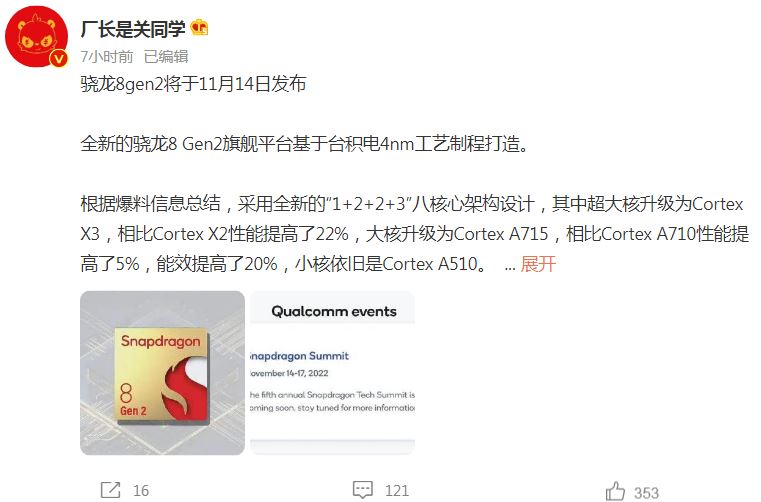
On the flip side, the tipster also recalls the major specs of the processor. From the base architecture to the performance-oriented functions, you can get a simplistic and detailed view of the flagship chipset here.
Snapdragon 8 Gen 2 – Major Specs
Snapdragon 8 Gen 2 firmly stands on the 4nm process technology. The Qualcomm manufacturer has equipped the advanced 1+2+2+3 octa-core architecture design. Further, the company has upgraded its ultra-large core to Cortex X3.
Comparatively, this addition increases the overall performance grade of the processor by 22 percent. Besides, the large-core structure gets an upgrade to Cortex A715. The functioning ratio of other Cortex (Cortex A710) has increased by 5 percent.
Though the small core still relies on the Cortex A510. But that doesn’t affect the benefits of the chipset. With new implementations, energy efficiency also gets rises by 20 percent. For the GPU segment, the chip will enhance the graphics with Adreno 740 and X70 5G. 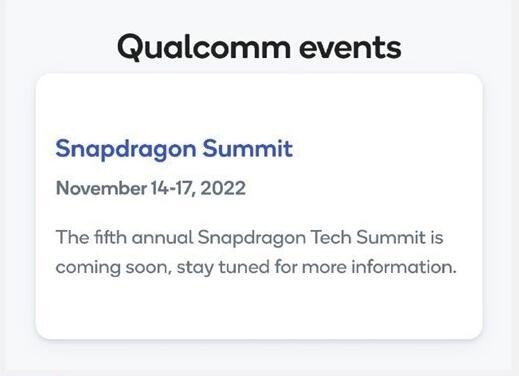
Is Huawei P60 the first to equip Snapdragon 8 Gen 2?
While consumers are waiting for the dynamic processor, a new leak says that the Huawei P60 series will appear on the platform with Snapdragon 8 Gen 2 processor. Will it be the first smartphone to bring the super advanced processor in its pocket, or is it just a rumor? Well, let’s wait till the Snapdragon 8 Gen 2 touches the ground.
Read More: Huawei P60 series to bring Qualcomm Snapdragon 8 Gen 2 chipset 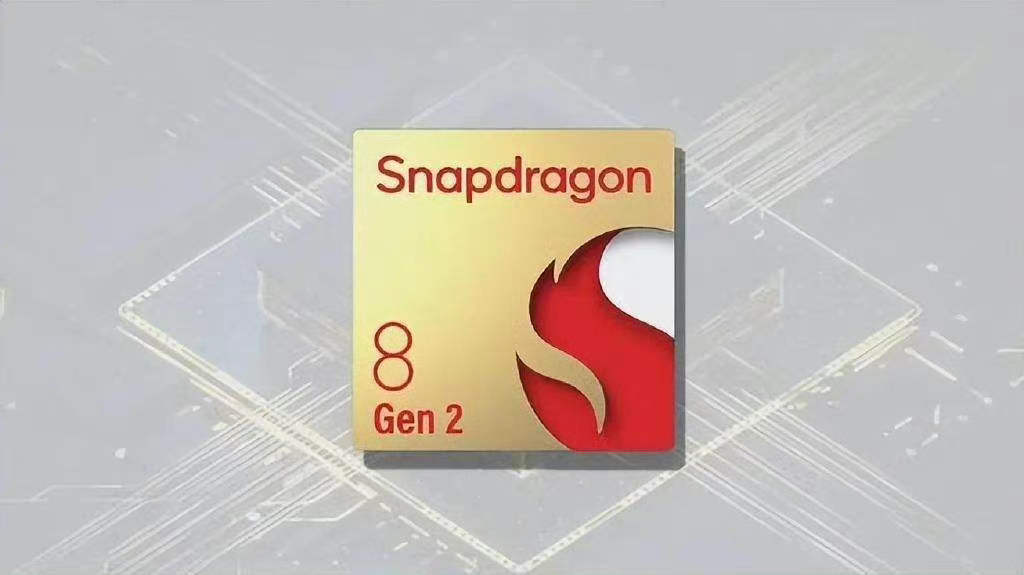
|| Source ||
Qualcomm Snapdragon 7+ Gen 1 processor is coming: Tipster
Intel 13th Gen Core Processor Family: Everything you need to know
Yash is a graduate of computer science and followed his way into journalism, he is interested in various subjects related to technologies and politics. Yash likes to listen classical songs and has a huge library of classical mixes.
2022, a tough year for Huawei smartphones but also crucial
Huawei and Qualcomm leads Wi-Fi 6 innovation
Huawei will launch two flagship phones in 2023: Supply Chain
Published
on
By
Huawei Nova 10 Pro is a gigantic member of the Nova family. The device comes into existence with several exciting features that can level up the user experience. However, the most reflecting technology of Huawei Nova 10 Pro is its 100W turbo-charging.
Yes, the company has done some amazing work with the Nova 10 Pro charging segments. Although, the devices hold several features to explore. Yet, turbo-charging is something that has drawn my attention a lot.
I think the battery is a very crucial part of a device. While purchasing a new gadget, users often check the battery specifications and its charging abilities. And why not, it is something that will power up our device and will keep it reliable in the time ahead.
Remember, a good battery and excellent charging functions can stretch the phone’s life to a long duration. It’s not us, but Huawei also understands this phrase. Hence, it equipped the latest Huawei Nova 10 Pro with a 100W turbo-charging facility.
100W turbo-charging – how does it work?
The Huawei 100W turbo-charging experience is worth praising. When I tried this technique for the first time, the results were surprising.
Ultimately, when you enable the turbocharging feature, it begins adapting the battery’s abilities. After plugging in the charger, the power suddenly jumps to 87W. After 3 minutes of super-fast charging, the power drops to 57W.
At this range, it continues to charge the device and slowly falls to 30W. Thereafter, it begins the background charging for 2-3 minutes with 26W power. Within or less than 10 minutes, the high-tech charging power up your device completely. 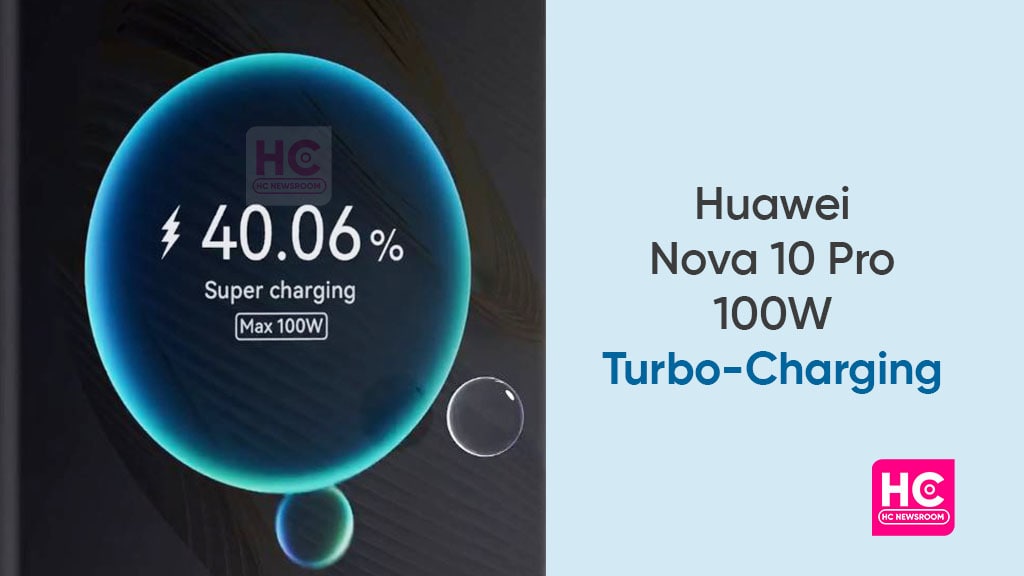
100W Turbo-Charging – good or bad?
Every technology has pros and cons. And so it follows on the charging as well. The turbo-charging may get affected by environmental factors. For instance, the temperature of your room, humidity, and more.
However, when we tried the turbo-charging effect under the ambient temperature of 30 degrees Celsius, the result was quite interesting.
- At 18.50 – 53% of charging
- At 18:53 – reaches 67%
- At 19:00 – 89% of the charging
- At 19:03 – 100% battery
Consequently, we can say that it takes 18-23 minutes to charge the device from 0 to 100 percent.
Notably, the battery capacity of Nova 10 Pro is only 4500mAh. In that aspect, turbo-charging operates in a very good manner. Moreover, it gradually increases and decreases the power level, so that your device may not get affected.
So far, Huawei has brought this technology with Nova 9 Pro smartphone. And now it’s playing wonders for users. With a 100W fast charger that offers turbo-charging, the device is good to go in your hands.
Any new charging technology is coming?
Well in recent times, we grabbed Huawei under a universal charging tech headline. As per the previous info, Huawei and some other companies have come across the table to find a universal solution for fast-charging adapters.
The new technique known as UFSC fusion (Universal Fast Charging Specification) will improve the charging facility. Further, it will contribute to the fast-charging ecosystem. It’s a simple way to unite different adapters with a revolutionary mechanism.
It’s believed, Huawei is doing great in terms of battery capacity. Even when the battery has low facilities, it is capable of boosting the entire functioning of the device. Well, a user most probably requires a phone that can survive for longer hours even when the battery is at a minimum percent. And the turbo-charging is perfectly offering these services.
Published
on
By
Huawei and its satellite communication are once again in the headlines. After Apple, it looks like Samsung is planning to follow Huawei and implement satellite communication technology on its flagship gadgets.
Satellite Communication technology is gradually becoming a trend in the market. In recent times, we come across several tech makers that are trying to adopt the respective feature for their devices or operating systems.
After Huawei, satellite communication enlisted Apple, Google (Android 14), and now Samsung. While Apple has already offered the benefits of satellite features with iPhone 14 series, Google and Samsung are in the preparation phase.
The latest information reveals that Samsung has associated with Iridium cooperation and is finalizing the satellite communication development for its next flagship smartphone – the Galaxy S23 series.
In our previous reports, we mentioned that Samsung is looking for a satellite connectivity provider other than Globalstar. This was so because Apple already merged with Globalstar for satellite features.
Thus, Samsung decided to take different steps in this tech concept. Eventually, it seems like the Korean tech maker has found the right companion to proceed with the new technology.
Samsung and Iridium
Speaking of the Iridium group, the cooperation utilizes the 66 low-orbit communication satellites. This framework offers effective voice and data communication services for users without any network hindrances.
On the flip side, the info states that Samsung has been working on satellite communication technology for the past two years. In the meantime, the company was dealing with antenna challenges as to how to make it a compact and power-efficient element.
Consequently, just like Huawei and Apple, Samsung’s main objective is to provide its users with immersive voice, messages, and image transmission facilities. And who knows, we could find the satellite tech with Galaxy S23 in the first quarter of 2023.
Satellite Communication – A long race!
Huawei is the first company to bring satellite communication features with the dynamic Mate 50 series. Ultimately, the feature is capable of relieving communication services even in low-area networks.
Thus, a user with Huawei Mate 50 smartphone can conduct calls, send a 19-20 characters text, scan a code 8-10 times, and generate trajectory maps and locations.
On the other hand, Huawei is making the corresponding feature more useful with the Mate 60. Yes, the internal tweaks suggest that the new version of this technology will enable two-way communications, sending voice messages, and making short voice calls as well.
It won’t be wrong to say that when it comes to technology and innovation, Huawei remains one step ahead.
Know More: Huawei Mate 60 may launch new Satellite Communication Features
Apple iPhone 14 series – SOS feature
Following Huawei, Apple also launched the iPhone 14 series with satellite features. It has implemented the Emergency SOS feature which combines with the software and connects antennas directly to the satellite.
As a result, this mechanism starts messaging functions with emergency services. Being an iPhone 14 user, you can use the feature under low-network or Wi-Fi coverage.
Android 14 is also on the list!
Yes, Android 14 has also appeared in the satellite communication headlines. The information states that Google is also making efforts and could initiate satellite features on the next coming Android version.
In the time ahead, we could see many competitors in this tech field. But it would be worth seeing which manufacturer will remain in the first position regarding satellite communication.
(Source)
Published
on
By
Today, Qualcomm launched the flagship chipset, Snapdragon 8 Gen 2 for smartphones and flagship Android devices. The ultimate processor is baked with the most advanced technologies such as smarter image processing, and Wi-Fi 7, and it could be featured on the P60 series.
According to Qualcomm, the new Snapdragon 8 Gen 2 chipset contains extraordinary implements over its predecessors. Accordingly, the new features will offer a boasting performance to the premium devices.
The latest flagship processor stands upon the 4nm process layout. Ahead, it leans on four performance cores that deliver better results than the previous chipsets. All these cores range between 200 and 300MHz.
Further, Qualcomm claims that both CPU and GPU are turbo elements and exhibit 40-45% of power saving. To count on the major additions, the company has introduced revamped AI structures, the super-ultra Wi-Fi 7 for extreme connections, and smarter image processing.
Let’s dive into the features of the newly-launched Qualcomm Snapdragon 8 Gen 2 chipset: 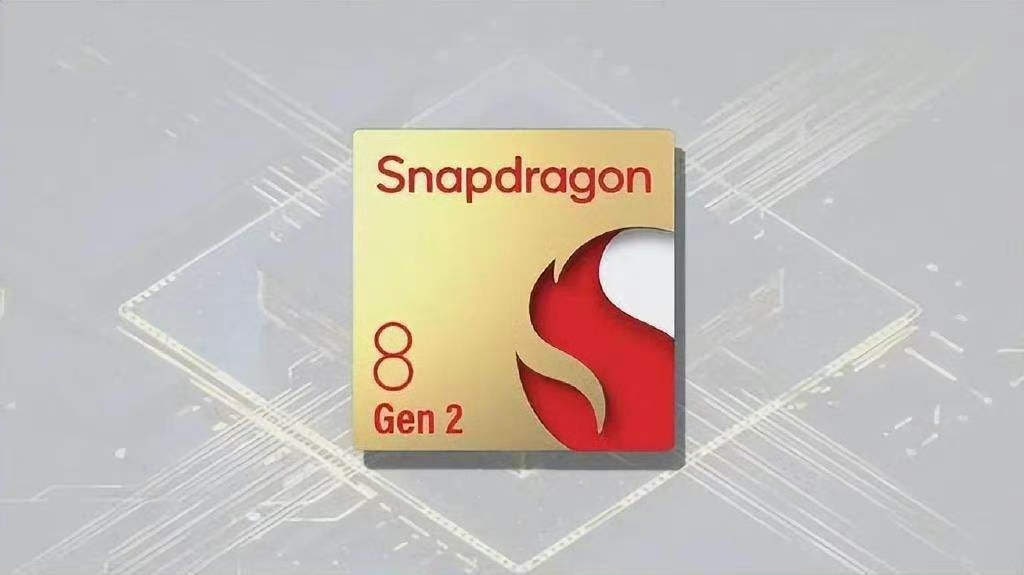
Progressive AI
The AI Engine comprises the Qualcomm Hexagon chipsets with innovative micro tile inferencing. Besides, it equips Tensor accelerators with up to 4.35 times faster AI performance than previous processors. It also supports the INT4 format for the first time which accelerates AI analysis performance by 60%.
Pro-Level Gameplay
The new Snapdragon 8 Gen 2 chipset adopts the amplified Adreno GPU that offers 25% faster graphics rendering.
On top of that, it features a full Snapdragon Elite Gaming arsenal that includes industry standards for Real-Time Hardware Accelerated ray Tracing, delivering authentic light, reflections, and illuminations for desktop-level gaming experiences.
Intelligent Camera functions
The effective Qualcomm Spectra installs a triple 18-bit cognitive ISPs and an Always-On Sensing camera. The optical components derive from the AI functions and enhance the real-time capture of photos and videos.
Together, these intelligent camera functions keenly inspect the objects in an image and apply image tuning accordingly. The chipset also supports iconic 200MP single captures with 3.2 gigapixels per second.
Accelerated Performance
Snapdragon 8 Gen 2 powers Kryo CPU cores which results in 35% faster performance and 40% finer battery efficiency. Additionally, the micro-architecture helps in converting one efficiency core into an additional performance core to achieve maximize multi-threaded performance up to 3.2GHz speed.
Advanced 5G Performance
Qualcomm has also added the Snapdragon X70 Modem-RF, which was announced earlier this year. This technology implies the Qualcomm 5G AI processor, Qualcomm Smart Transmit, and Qualcomm 5G PowerSave.
These all variants offer the latest advancements in speed, network coverage, and high-range link, and effectively support dual 5G SIM activation at the same time.
First-Ever Wi-Fi 7
Snapdragon 8 Gen 2 chip brings the first commercial Wi-Fi 7 with High Band Simultaneous (HBS) Multi-Link, on the new FastConnect 7800 board. The new system delivers VR-class low-latency, more than doubling Wi-Fi 6 speeds up to 5.8Gbps.
Apart from these functions, the newly-released chipset also supports Dual Bluetooth, LE Audio, and Snapdragon Sound with spatial audio for immersive audio experiences. 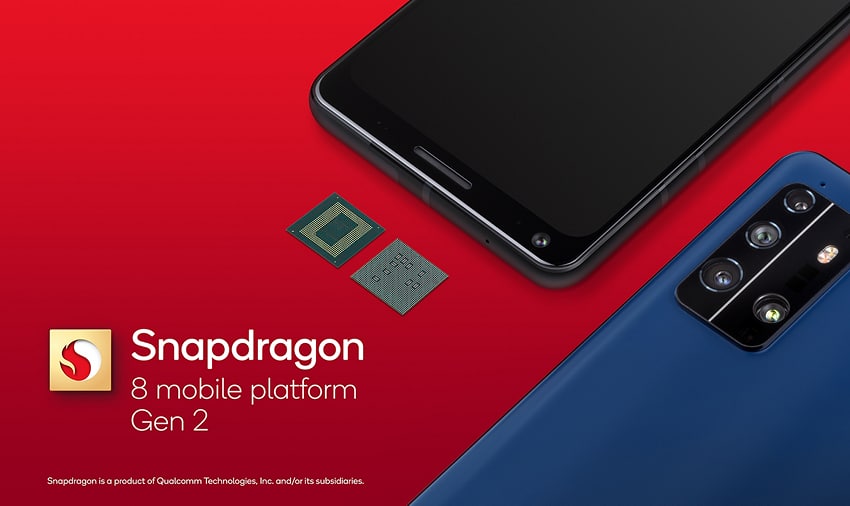
Huawei P60 series could feature Snapdragon 8 Gen 2
While several smartphones are waiting to taste the new processor, the Huawei P60 series also falls on this list. The phone has been rumored many times to bring the Snapdragon 8 Gen 2 chipset on its surface.
Adding to this, Qualcomm has now released its premium processor and it’s time to wait for Huawei’s upcoming flagship. Notably, the P60 series is expected to make its debut in the first quarter of 2023.
Whereas, Qualcomm said that the latest processor will start appearing in high-end phones by the end of 2022, and will make a complete space in 2023 Android devices. Probably, the rumors of Snapdragon 8 Gen 2 for P60 models will soon turn into reality.
Read More: Huawei P60 series to bring Qualcomm Snapdragon 8 Gen 2 chipset
(Source)
Copyright © 2022 Huaweicentral.com